
Amazon Audible Gift Memberships

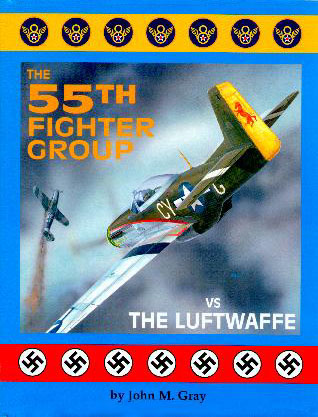
August 1943 was an especially bleak month for the 8th Air Force.
Major heavy bomber raids on Schweinfurt and Regensburg had been
devastating for the American precision bombing effort against Germany.
Flying deep into Germany, unescorted beyond the German border, 60 B-17s were shot down by
Luftwaffe fighters and flak. 168 more were damaged, and four of those were
beyond repair. It appeared that deep penetrations into the heart
of Germany would be extremely costly for the foreseeable future,
or until long-range escort fighters were available to protect the
bomber formations to and from the target.
This emergency resulted in two Fighter Groups being dispatched to Britain with the greatest possible speed. These were the 20th and 55th Fighter groups, with the 55th being the first to go operational. Arriving in mid September, the 55th lacked any aircraft. Towards the end of the month, a mixed bag of P-38H and early model P-38Js began to filter their way to the group. With no time being allotted for high altitude operational training, or even the slightest briefing on enemy capabilities or tactics, the 55th was thrown into the cauldron. Declared operational on 15 October 1943, they were a day too late to have been of any value during the second, equally disastrous raid back to Schweinfurt.
After flying sweeps and escorting medium bombers into France, weather delayed their first escort mission into Germany until November 3rd, when the three fighter squadrons that constituted the Group were hurled into an air war over the Reich, for which, they had no preparation whatsoever. Nonetheless, the 55th would learn the lessons that would be passed on to the following hoards of P-51 Mustangs in the months to come.
John Gray has documented the trials and tribulations of this Fighter Group that was at the very tip of the 8th Air Force's spear aimed at the heart of German industry. Gray interviewed many of the 55th's surviving pilots, and many of the Luftwaffe pilots who opposed them. The resulting effort is a spellbinding narrative that reads easily, but still presents the reader with the urgency of the time and nature of air combat over Germany. Well illustrated with photographs (even some Kodachromes) and color plates, the book is essential reading to understand why those flying the P-38 Lightning suffered so much during the early months of the fighter's deployment in the ETO. We at Planes and Pilots of WWII highly recommend The 55th Fighter Group vs The Luftwaffe for both the serious student of WWII aviation and the casual reader as well.
The book may be purchased from any of the major online booksellers for under $25, and is well worth the investment. ISBN-13: 978-1580070041
Corey C. Jordan, Editor
The Planes and Pilots of WWII Internet Magazine

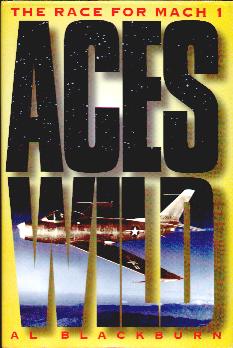
Every once in a while, a book is written that does far more than simply entertain
or inform. It thrills, it inspires, and it enlightens the reader. Aces Wild: The Race
For Mach 1 is such a book.
Al Blackburn takes the reader on the wild ride to do what many had thought impossible: Exceed the speed of sound. The author introduces one to a myriad of unique characters, those free spirits who defied the conventional wisdom and pushed the performance envelope beyond reasonable limits of safety.
Mr. Blackburn shoots some very big holes in the long accepted belief of who was the first man to fly at supersonic speed. Blackburn provides convincing evidence to support his revelations. Almost certainly, the Air Force and NASA establishment will be shaken by what this book presents.
From the opening pages, readers will find themselves engrossed in the atmosphere of the post World War II technology boom that swept aviation along at a breakneck pace. The mind numbing speed of development is carefully documented with great attention to detail, not only of the aircraft, but also of the intrepid men who flew them.
The main characters of this drama, both highly regarded fighter aces; become bigger than life. One would become a household name; the other relegated to obscurity. Mr. Blackburn weaves the significant events of their lives into the story until these men become the story.
Not only does Al Blackburn understand the technology of supersonic flight, he was one of those pioneering aviators who pushed the envelope. As a former test pilot for North American Aviation, and being one of this close knit cadre of daring professionals, Mr. Blackburn writes with an authority and sagacity rarely seen. The writing style reflects the clearness of thought that is absolutely necessary to survive the rigors of being a test pilot. The reader never has to make an assumption. Assumptions are deadly to test pilots.
Aces Wild is an important book. It is important because it uncovers and exposes truths long hidden. It is important because it brings to the light of day the deeds of a great pilot who quietly, without fanfare, set the Air Force on it's ear in 1947. It is important because finally, it ascribes credit where it has been long overdue. Moreover, this book is important because it provides a firsthand account of the most significant era of aviation since the Wrights first teetered off the launch rail at Kittyhawk.
Corey C. Jordan, Editor
The Planes and Pilots of WWII Internet Magazine

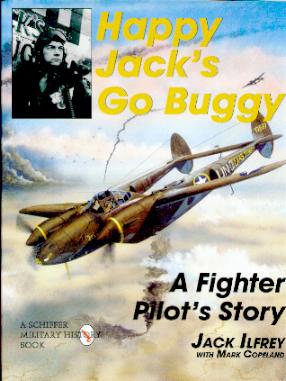
Having grown up on a steady diet of 1940s and 50s war movies, I thought
that most of the characters and their wild exploits were the work of
overly imaginative writers. By and large, my belief was accurate. Recently
though, I was introduced to a man and his true story that has caused me
to reconsider the deeds of derring-do seen on film.
Jack Ilfrey (ILFREY) is a real life cross between Hans Solo and Indiana Jones. Of course, Jack predates those fictional characters by more that 35 years. Flying P-38 Lightnings and the P-51 Mustang, Jack was involved in events that would leave Steve Canyon trembling like a mouse.
Forced to make an emergency landing in a very German friendly Portugal, Jack escaped internment by tricking the local military authorities into refueling his P-38F. Once that was accomplished, he offered to show them how to start the engines. With Portuguese officers still kneeling on the wings, Jack firewalled the throttles and pulled the canopy closed as his hapless captors were blown off like leaves. Without the time to taxi to a runway, Ilfrey takes off straight ahead. He then navigates to Gibraltar by compass alone. The diplomatic flap caused by Jack's bold escape results in the State Department demanding that he be sent back! General Jimmy Doolittle would have none of that. He needed men with Ilfrey's genius and unflappable nerve. Jack Ilfrey would go on to be America's first fighter pilot to gain ace status against the Luftwaffe.
The title, Happy Jack's Go Buggy, comes directly from the name of his P-38 and P-51 fighters. The unusual name bestowed on his fighters reveals a unique type of pilot. Indeed, Jack could be considered the archtypical model of the crazy-ass, wild-eyed American fighter jockey to appear in later American war films.
Of the many combat pilot memiors that I have read, Jack's stands out as the most entertaining and most inspiring of the lot. There can be no doubt that Ilfrey was a tried and true American hero. He was also one of America's greatest characters to emerge from the war. If you enjoy reading about fighter pilots, run, do not walk, to you nearest bookstore and get this wonderful book.
Corey C. Jordan, Editor
The Planes and Pilots of WWII Internet Magazine

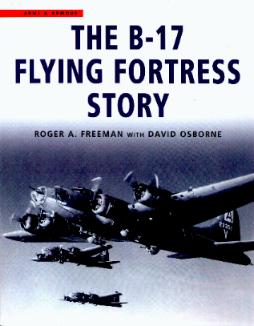
When I heard that Roger Freeman had written a new book about the B-17,
I ordered a copy more than a month before the release date. As the weeks
crawled by, I looked forward to the book ariving. After all, this is a
Freeman book. Finally, it showed up and I opened the box with high expectations.
However, after ten minutes of turning pages, I found myself somewhat disappointed.
It wasn't what I had expected. Not even close. Now, don't get me wrong,
there is nothing wrong with Freeman's latest effort. In fact, it is a remarkable
accomplishment. It's just that the title is somewhat misleading.
There are certainly a great many different volumes, both in print and out, that cover the B-17's combat record quite well. Likewise, there are some outstanding books that present the aircraft itself in great detail. Peter Bowers' rare Fortress in the Sky, being the best of these. Freeman decided to cover an aspect never fully explored before, and in this regard, it is both unique and valuable for the historian and the dedicated B-17 fan. Of the 319 pages that make up this effort, only the first 69 pages present anything that could be considered as being the "B-17 story". The balance of the volume presents a very brief 4-5 line "history" of every B-17 ever produced. This data is listed by serial number and tells you where the bomber was made, who operated it and its final disposition. Since no one has presented this information in a comprehensive format before, this is truly a valuable asset for those who wish to do deep research on individual aircraft. Therefore, the book's value cannot be underestimated. However, for the average aviation or World War II reader, far more entertaining books are to be had.
So, if you are a true B-17 junky or historian, then I would recommend this book without reservation. On the other hand, if you are reading for pleasure, I suggest that you try something not as narrowly focused.
Corey C. Jordan, Editor
The Planes and Pilots of WWII Internet Magazine

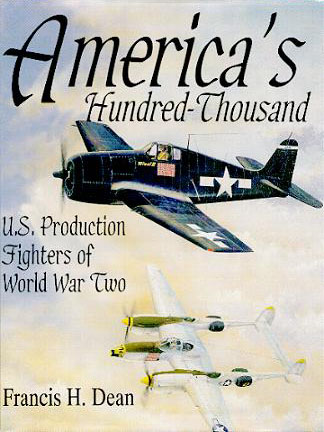
There are a few books that the World War Two aviation enthusiast
absolutely must have in their collection. America's Hundred
Thousand is certainly one of those books. Any compilation of WWII
works would be the lesser for not including this monumental volume.
Having offered up this rather strong statement, I can assure the
reader that Dean's book measures up to this standard of approbation.
To this writer's knowledge, no other book produced comes close to America's 100k in depth or in scope. Dean presents the major American fighter types with the goal of defining every aspect of the aircraft's history, design, construction and performance. In his quest, the author has been successful in the extreme.
Mr. Dean covers the following types: The Air Corps' P-38, P-39, P-40, P-47, P-51, P-61 and P-63. For the Navy and Marine Corps, Dean presents the F2A, F4F, F4U and the F6F.
From the title page on, America's 100k displays the finest period photography available. Much of these wonderful images come from Mr. Dean's extensive personal collection. In addition, Dean has enlisted Pete Bowers and his huge library of photos and negatives. If the book was no more than a photographic history, it would worth every penny. However, there is much more here than the outstanding photography.
There are hundreds of charts, stats and manufacturer's drawings. Each system and sub-system of the eleven featured fighters are described in great detail. As are the individual flying qualities, design and construction of each type. Yet, Dean does not stop here. His accompanying text is rich with details and a wealth of data. Virtually every one of the 606 pages is jammed with the kind of information that most serious aviation enthusiasts tend to drool over. However, it is for exactly these reasons that this book may a bit too much for the casual or infrequent aviation reader.
In terms of design and layout, the book is impeccable. America's 100k is structured in a manner that allows for easy reading and research. Paper quality is first rate and typical of Schiffer's recent top-notch efforts. The binding is excellent and the dust jacket is remarkably attractive as one can see above. While some may recoil at the suggested cover price of nearly $60, if price were based upon value, sixty bucks is dirt cheap. Indeed, this may very well be the best $60 investment you will ever make in an aviation book.
Corey C. Jordan, Editor
The Planes and Pilots of WWII Internet Magazine

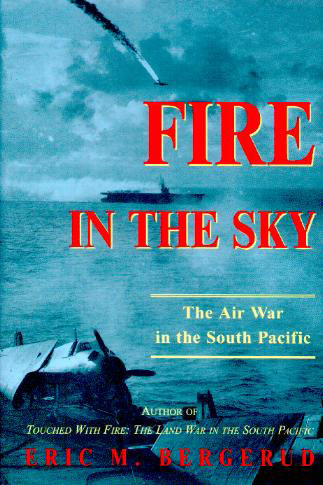
With the Japanese attack on the U.S. naval base at Pearl Harbor, a
series of stinging military disasters would punish American and Allied
forces, and push them back across the whole of the Pacific for the next
six months. The strategic victory in the Battle of the Coral Sea,
followed by the staggering beating suffered by the Imperial Japanese
Navy in the waters northwest of Midway island finally halted the
relentless military juggernaut of Japan.
For the next two years one of the hardest fought battles raged in the South Pacific. Places like Guadalcanal, New Guinea, Bougainville and Rabaul would fill the headlines in American newspapers across the country. A great many books have been written about various aspects of this especially difficult theater of operations. However, few of these have addressed in depth the complex campaign waged by both sides for control the air. Eric Bergerud's newly released Fire in the Sky: The Air War in the South Pacific, does exactly that.
When I received a copy of Fire in the Sky from the publisher, I was instantly impressed with its sheer heft. This is no small work of history. There was no doubt in my mind that this was going to take a great deal of time to wade through. In all likelihood, it probably would take weeks to finish.
I finished the book within five days. Then, I read it again, cover to cover. I confess that this book caused me to fall behind on several projects and pushed me right up to a deadline or two. Rarely do I spend more than an hour reading for pleasure. My daily schedule simply doesn't allow for more. Nonetheless, I devoured Fire in the Sky in huge chunks, pouring over chapter after chapter for hours at a sitting.
So, you may wonder; what is the attraction of this book?
First and foremost, it is excellent history. Yet, there is no hint of the dry, colorless narration that hallmarks much of the work that attempts to encompass the breadth and scope that Mr. Bergerud has so ably captured in this remarkable volume. Nearly every page provides a revelation.
Fire in the Sky is possibly the very best analysis of a major air campaign ever placed in print. Bergerud's consummate writing style is very entertaining, his skillful use of personal anecdote combined with the detachment of a historian, blend into compelling reading and a truly enjoyable experience.
Warts? A few. I cannot imagine a 700 page monster such as this without any. Still, these are generally related to technical subject matter and in no way take away from the completeness of Bergerud's triumph, and a triumph it is. Having also read his wonderful Touched by Fire: The Land War in the South Pacific, I can say without hesitation that this new work not only complements Touched by Fire, it surpasses it.
Destined to be the definitive history of the air war in the South Pacific, no serious student of World War Two or aviation can afford not to have this book in their personal library.
Corey C. Jordan, Editor
The Planes and Pilots of WWII Internet Magazine
